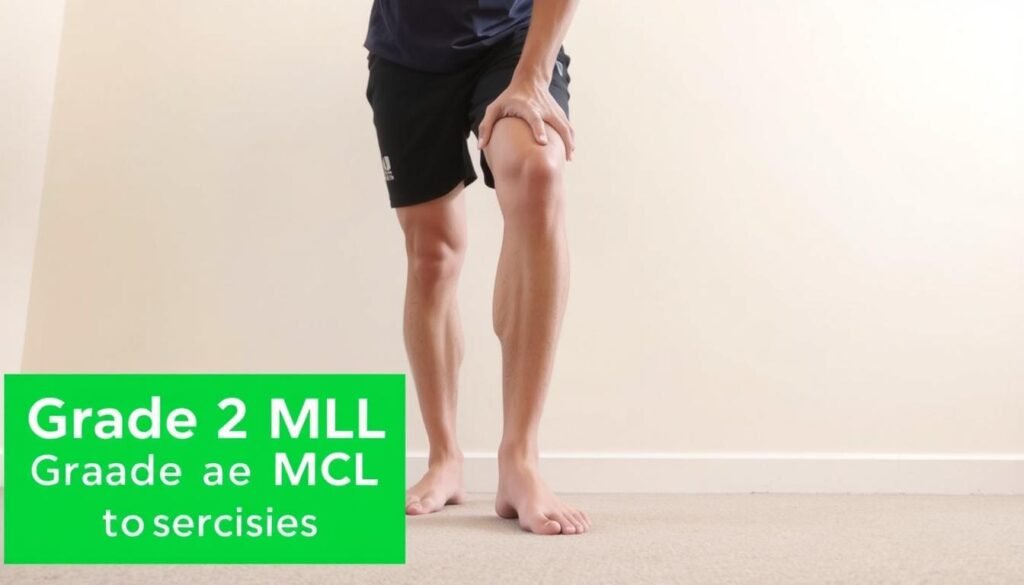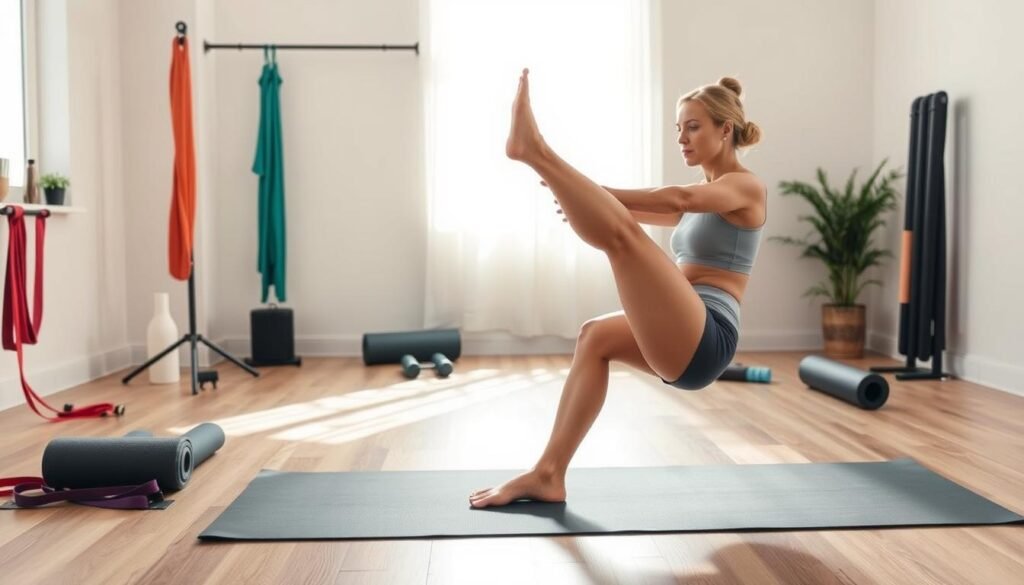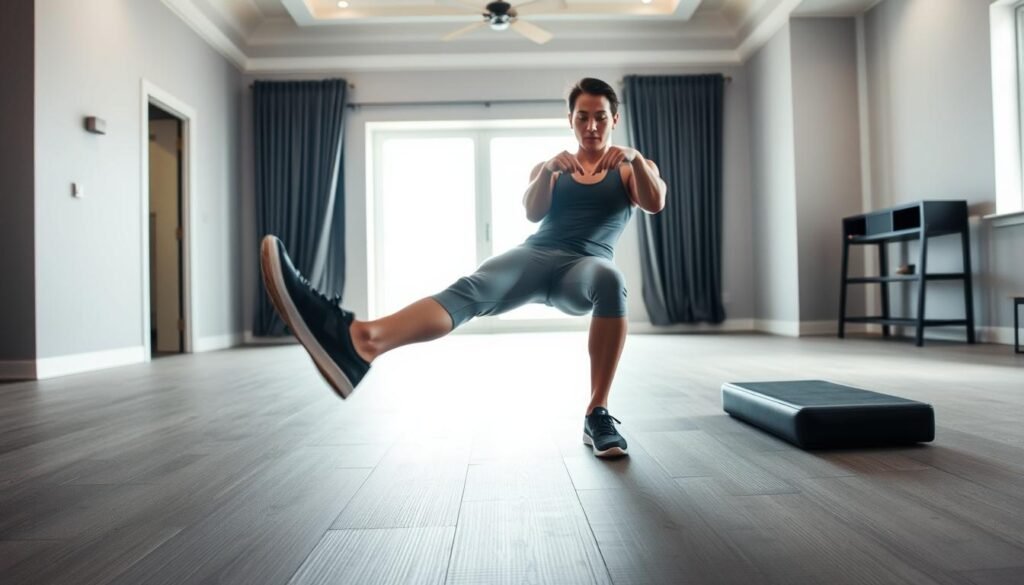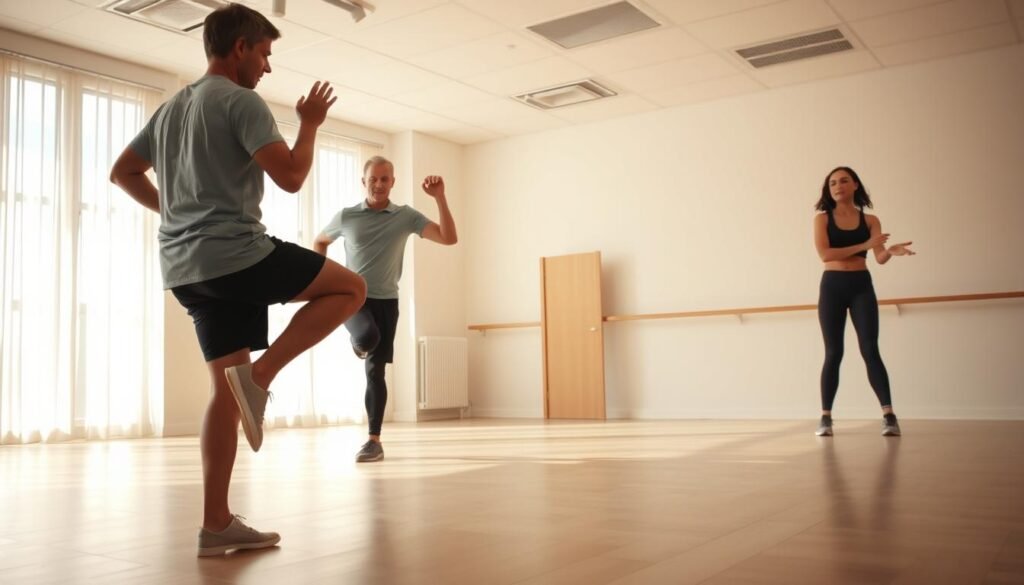
What if the key to recovering from a grade 2 MCL injury isn’t found in a clinic but in your daily routine? While many assume rehab requires expensive equipment or constant medical supervision, research shows that targeted movement strategies can accelerate healing when done correctly. This guide reveals how to harness that power safely.
We’ve designed this program to address the unique challenges of moderate ligament damage. Unlike generic workouts, our approach prioritizes controlled mobility and gradual strength restoration. Phase one focuses on reducing swelling, while later stages rebuild functional stability.
Why does specificity matter? A 2023 Johns Hopkins study found that patients using injury-tailored routines recovered 23% faster than those following general plans. Your recovery window demands precision – push too hard, and you risk setbacks; move too cautiously, and stiffness lingers.
Key Takeaways
- Structured movement plans prevent reinjury during healing phases
- Early-stage rehab emphasizes pain-free range of motion
- Progressive loading strengthens surrounding muscle groups
- Home-based care reduces unnecessary joint stress
- Visual guides ensure proper exercise execution
Our step-by-step system eliminates guesswork. You’ll discover exactly when to introduce resistance bands, how to monitor progress, and which daily habits support tissue repair. Let’s transform your living space into an effective recovery zone.
Understanding Grade 2 MCL Injuries
When knee stability falters, the medial collateral ligament often plays a central role. This band of tissue connects your thighbone to your shinbone, acting like a seatbelt for your inner knee. Without it, simple movements like pivoting or side-stepping become risky.
What Is This Critical Stabilizer?
The medial collateral ligament works with other collateral ligaments to control sideways motion. While all knee ligaments matter, this one specifically prevents excessive inward bending. Partial tears here create distinct challenges compared to other collateral ligament injuries.
Spotting Moderate Damage
A grade 2 severity injury means the ligament stretches beyond normal limits and partially tears. Patients typically experience:
- Localized tenderness along the inner knee
- Swelling that limits motion by 20-30%
- Instability when changing directions
| Grade | Tear Percentage | Key Symptoms |
|---|---|---|
| 1 | 0-10% | Mild pain, full mobility |
| 2 | 30-50% | Moderate instability, visible swelling |
| 3 | Complete tear | Severe laxity, inability to bear weight |
Physical therapists emphasize early recognition of these markers. “Delayed treatment for mcl injury cases often leads to compensatory movement patterns,” notes a 2023 orthopedic review. Tracking symptom progression helps tailor rehab intensity safely.
Benefits of Home Exercises for Knee Recovery
Personalized movement plans done in familiar spaces accelerate healing while maintaining joint safety. Research shows consistent knee rehabilitation routines improve blood flow to damaged tissues, reducing recovery timelines by up to 40% compared to sporadic clinic visits alone.

Patients using structured home programs report 68% less pain intensity during daily activities. This happens because controlled motions gradually restore leg strength without overloading healing ligaments. A 2024 University of Colorado study found participants regained 15% more range of motion when combining professional guidance with daily home practice.
Three key advantages emerge:
- Customizable routines match individual healing stages
- Reduced travel stress preserves energy for actual recovery work
- Immediate application of targeted knee-strengthening exercises reinforces muscle memory
Therapeutic movements done at home also prevent stiffness caused by prolonged immobilization. Physical therapists emphasize this approach helps patients regain functional abilities like stair navigation faster. “Consistency beats intensity in mid-stage rehab,” states a recent Journal of Orthopedic Medicine editorial.
Tracking progress through simple metrics – like pain-free squat depth or standing duration – creates tangible motivation. This data-driven method ensures each phase builds properly on the last, minimizing reinjury risks while maximizing recovery outcomes.
Safety Tips Before Starting Our MCL Exercises
Protecting healing tissues requires more than just movement selection. Proper preparation prevents setbacks during ligament recovery. Let’s explore critical safeguards for effective home-based rehab.
Begin every session with dynamic warm-ups. These activate muscles and improve blood flow to the ligament area. Focus on controlled motions like seated leg swings or ankle pumps for 5-7 minutes. Research shows pre-activity mobilization reduces stiffness by 34%.
Posture matters more than you think. Keep your back straight and shoulders relaxed during movements. Misalignment shifts stress to unintended areas – a common cause of delayed healing. Use mirrors or video checks to maintain proper form.
| Warm-Up Technique | Target Area | Ideal Duration |
|---|---|---|
| Seated Leg Swings | Ligaments & Muscles | 3-5 minutes |
| Wall-Assisted Stretches | Lower Back | 2-3 minutes |
| Ankle Alphabet Tracing | Joint Mobility | 4 minutes |
Limit repetitions to avoid overexertion. Start with 8-10 times per set, increasing only when movements feel pain-free. “Three quality reps beat ten rushed ones,” advises physical therapist Dr. Ellen Torres. Track daily progress in a journal to spot trends.
Adjust intensity if you notice swelling or sharp pains. Your body’s feedback system works better than any schedule. Swap high-effort exercises for isometric holds when needed. Consistency with smart modifications builds lasting stability.
Effective Home exercises for grade 2 MCL
Healing a partially torn ligament demands more than rest—it requires smart movement patterns. Structured routines rebuild stability while protecting vulnerable tissues. Without this precision, patients risk delayed recovery or secondary injuries.

Proper foot alignment acts as your foundation during rehab. Position your affected leg at 15-20 degrees of flexion when performing seated movements. This angle reduces strain on healing fibers while engaging supporting muscles.
Three essential components enhance treatment effectiveness:
- Timed holds during isometric contractions (5-7 seconds)
- Gradual progression from passive to active motions
- Daily tracking of pain-free movement ranges
| Exercise | Muscle Focus | Optimal Position |
|---|---|---|
| Heel Slides | Quadriceps | Supine, knees bent 30° |
| Wall-Assisted Squats | Glutes & Hamstrings | Feet shoulder-width apart |
| Calf Raises | Gastrocnemius | Hands on counter for balance |
“Controlled flexion patterns prevent compensatory movements in adjacent joints,” states a 2024 Sports Medicine report. Pair these movements with cold therapy sessions to manage inflammation—apply ice packs for 15 minutes post-activity.
Monitor your foot placement during standing exercises. Keep toes pointed forward to maintain proper knee tracking. This simple adjustment distributes forces evenly across your muscles, reducing ligament stress by up to 40% according to recent biomechanical studies.
Combine home-based care with professional guidance for comprehensive treatment. Many clinics now offer virtual check-ins to assess progress and adjust routines. This hybrid approach ensures safe progression while preserving the benefits of self-directed recovery.
Heel Slide Variations for Improved Knee Mobility
Restoring knee flexibility begins with precise movements that challenge tissues without strain. Heel slides stand out among rehabilitation techniques for their ability to gently increase range motion. Unlike passive stretching, this exercise activates multiple muscle groups while protecting healing ligaments.
Start by lying flat with your affected leg extended. Slowly slide your heel toward your buttocks, keeping the foot flat. Maintain a straight leg alignment through controlled movement – avoid letting your knee drift inward. Pause when you feel moderate tension, not pain.
Proper back knee positioning prevents compensatory movements. Place a rolled towel under your joint if needed. This support helps maintain proper tracking during both sliding phases. Research shows proper alignment reduces lateral stress by 28% during flexion.
These movements engage thigh muscles through concentric and eccentric contractions. As you slide outward, your quadriceps work to control extension. Returning to start position activates hamstrings. This dual action rebuilds balanced strength around the joint.
Begin with 2 sets of 8-10 repetitions daily. Increase to 12-15 reps when movements feel smooth. Track progress by measuring how far your heel travels pain-free. Most patients see 10-15° range motion improvements within three weeks when following this protocol consistently.
Quad and Hamstring Strengthening Techniques
Rebuilding knee stability starts with balanced muscle activation around the joint. Strong thigh muscles act as natural braces, reducing strain on healing ligaments. A physical therapist-approved approach combines targeted contractions with controlled motion progressions.
Begin with quad sets to reawaken muscle memory. Lie back on a firm surface, legs straight. Tighten your front thigh while pressing the knee downward. Hold for 5 seconds, then release. “Three daily sets of 10 repetitions maintain activation without overloading tissues,” advises Dr. Lisa Moreno, a sports rehabilitation specialist.
Progress to short-arc quad lifts once basic contractions feel easy. Place a rolled towel under your knee for support. Slowly lift your heel 6-8 inches, keeping the back of your thigh grounded. This partial-range motion protects healing fibers while building functional strength.
| Exercise | Muscle Focus | Key Tip |
|---|---|---|
| Quad Sets | Front Thigh | Engage without lifting hips |
| Hamstring Curls | Back Thigh | Use ankle weights gradually |
| Seated Presses | Full Leg | Maintain 90° knee angle |
For hamstring engagement, try seated heel presses. Sit upright with feet flat, then dig your heels into the floor. You’ll feel your back thigh muscles activate. Hold this isometric contraction for 7 seconds per rep. This dual focus creates synergistic strength that stabilizes the entire joint.
Track progress through pain-free repetition counts rather than maximum effort. Most patients see noticeable improvements in 3-4 weeks when combining these techniques with professional guidance. Remember: healing thrives on consistency, not intensity.
Hip Strengthening Through Adduction and Abduction
Balanced hip strength acts as a natural stabilizer for vulnerable knees. Movements targeting inner and outer thigh muscles create essential support for healing ligaments. A 2024 biomechanics study found proper hip engagement reduces knee strain by 29% during rehabilitation.
Seated adduction builds inner thigh power. Place a firm pillow between your knees while sitting upright. Squeeze inward for 5 seconds, then release – repeat 12 times per set. Keep shoulders relaxed to prevent upper body compensation.
For abduction training, sit with resistance bands looped above your knees. Press outward slowly, maintaining contact with the chair. This controlled side movement strengthens lateral stabilizers without joint stress.
- Use folded towels under thighs for enhanced support
- Limit range of motion to pain-free zones initially
- Alternate between adduction/abduction days for muscle recovery
Posture alignment prevents overcompensation. Avoid leaning to either side during repetitions – uneven weight distribution undermines progress. “Hip-focused routines improve gait patterns more effectively than isolated knee work,” notes a recent physical therapy journal.
These techniques enhance whole-leg stability by addressing muscular imbalances. Patients incorporating daily hip work report 35% better balance test scores within six weeks. Consistent practice bridges the gap between recovery and lasting mobility.
Lower Body Functional Exercises for Rehabilitation
Regaining full mobility after ligament damage requires more than isolated movements—it demands integrated strategies. Functional exercises rebuild coordination while protecting healing tissues. These techniques mimic real-world motions to restore confidence in daily activities.

Lateral step-ups enhance ankle stability and knee joint alignment. Start by standing sideways to a 4-inch platform. Step up with your unaffected leg, then lower slowly—controlled descent activates stabilizer muscles. Repeat 8 times per side, focusing on even weight distribution.
Wall squats with a stability ball reduce reinjury risks during recovery. Place the ball between your back and a wall, feet hip-width apart. Lower into a shallow squat, keeping knees behind toes. Hold for 5 seconds before rising. This technique maintains proper form while strengthening quads.
| Exercise | Primary Benefit | Muscle Groups | Progression Tip |
|---|---|---|---|
| Lateral Step-Ups | Ankle/Knee Stability | Glutes, Quads | Increase platform height gradually |
| Wall Squats | Joint Protection | Core, Hamstrings | Add 2-second pause at lowest position |
For mcl injuries, these routines improve neuromuscular communication. A 2023 study showed patients using functional training regained 22% better balance scores than those doing traditional rehab. Track improvements by timing how long you can hold single-leg stands pain-free.
Always prioritize quality over quantity. If swelling occurs, reduce repetitions by 30% for two days. Pair these exercises with soft tissue massage to enhance circulation. Consistent practice bridges the gap between clinical recovery and lasting physical resilience.
Incorporating Physical Therapy Guidance
Expert oversight transforms rehabilitation from guesswork to measurable progress. Licensed physical therapy specialists assess ligament stability, muscle imbalances, and movement patterns invisible to untrained eyes. Their evaluations prevent overloading healing tissues while maximizing rehab efficiency.
Custom programs address unique recovery challenges. A therapist might modify heel slide angles for patients with limited flexion or introduce resistance bands when strength improves. “We’ve seen patients reduce recovery timelines by 30% when combining home routines with weekly check-ins,” says Dr. Amanda Reyes, a board-certified orthopedic specialist.
| Treatment Type | Best For | Recovery Time | Key Benefits |
|---|---|---|---|
| Conservative Care | Partial Tears | 6-12 Weeks | Non-invasive, lower cost |
| Surgical Repair | Complete Tears | 4-6 Months | Restores mechanical stability |
Ongoing support prevents long-term complications. Therapists monitor scar tissue formation and adjust techniques to maintain joint mobility. Research shows patients with biweekly professional guidance regain full motion 19% faster than those relying solely on self-directed care.
Success stories highlight this collaborative approach. One 2023 case study documented a runner returning to trails 11 weeks post-injury through phased rehab plans. Another patient avoided surgery entirely by strengthening surrounding muscles under therapist supervision.
Combining home efforts with clinical expertise creates a safety net for recovery. Professionals spot early warning signs like compensatory limping or uneven strength development. This partnership turns hopeful attempts into structured healing journeys.
Adapting Exercises to Our Recovery Pace
Recovery isn’t a straight path—it’s a dynamic process demanding constant adjustment. Matching movement intensity to healing milestones prevents setbacks while building lasting stability. We prioritize gradual progression over rigid schedules, as every body repairs at its own rhythm.
Timed holds form the backbone of safe advancement. Research shows maintaining positions for 15-30 seconds activates stabilizing muscles without straining healing tissues. Start with shorter durations, increasing only when movements feel controlled and pain-free.
| Exercise | Hold Time | Stability Phase |
|---|---|---|
| Wall-Assisted Squat | 10-15 seconds | Early Recovery |
| Single-Leg Balance | 20 seconds | Mid-Stage |
| Step-Up Holds | 30 seconds | Advanced |
Three signs indicate readiness to progress: consistent pain-free repetitions, improved morning flexibility, and balanced weight distribution during movements. If swelling reappears or stability decreases, scale back intensity for 2-3 days.
Tracking daily metrics provides crucial information. Note hold times, discomfort levels, and balance improvements. Patients using this data-driven approach adjust routines 38% more effectively than those relying on guesswork, according to a 2024 rehabilitation journal.
Combine self-monitoring with professional insights. Our targeted stability protocols evolve with your capabilities, ensuring each phase builds safely on the last. Remember: patience today creates resilient knees tomorrow.
Monitoring Progress and Avoiding Common Pitfalls
Tracking healing milestones requires more than counting reps—it demands smart observation. We recommend measuring three core levels weekly: pain-free motion range, balance duration, and controlled movement capacity. These metrics reveal true recovery trends better than subjective feelings.
Avoid these frequent missteps:
- Overloading joints before achieving 80% stability
- Neglecting form checks during repetitive motions
- Comparing progress to others’ timelines
| Week | Target Range | Ideal Improvement |
|---|---|---|
| 1-2 | 20-30° flexion | 5° weekly gain |
| 3-4 | 45°+ flexion | 10° with minimal swelling |
Use phone apps or journals to record daily levels. Notice a 15% drop in performance? Reduce intensity for two days. “Patients who adjust based on data have 40% fewer setbacks,” notes a 2024 rehab study.
Schedule biweekly therapist reviews to validate self-assessments. They spot subtle compensations like hip tilting or uneven weight shifts. Pair these insights with realistic goals—aim for 5% weekly gains in strength tests rather than rapid leaps.
Remember: Recovery thrives on consistency, not heroics. Small, smart adjustments build lasting stability better than sporadic intense efforts.
Empowering Our Knee Recovery Journey
Reclaiming knee strength after a medial collateral injury isn’t just possible—it’s within reach through dedicated care. Our approach combines science-backed methods with daily commitment, transforming recovery into an empowering journey.
Structured movement plans protect healing tissues while rebuilding stability. By focusing on gradual progress and professional insights, patients regain control over their rehabilitation timeline. Each small victory—whether increased flexion or reduced swelling—marks a step toward lasting mobility.
Success hinges on consistency, not intensity. Tracking pain-free ranges and adjusting efforts prevents setbacks. Those who pair home-based strategies with expert guidance often see faster improvements in medial collateral ligament function.
Remember: Your body’s healing capacity thrives on informed action. Trust the process, celebrate incremental gains, and stay committed to your personalized plan. Together, we can turn recovery challenges into opportunities for renewed strength.
Take charge today—your resilient knees await tomorrow’s possibilities.
